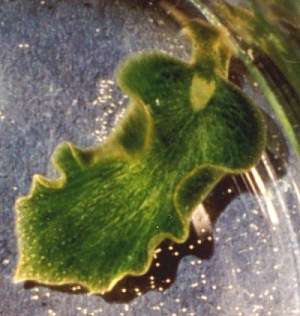
Elysia chlorotica
Gould, 1870
Order: SACOGLOSSA
Superfamily: ELYSIOIDEA
Family: Elysiidae
DISTRIBUTION
East coast of Nth America from Nova Scotia to Florida.
PHOTO
Martha's Vineyard, Massachusetts, USA, November, 1999. PHOTO: Dr. Mary Rumpho.
Typical elysiid shape with large lateral parapodia which fold over to enclose the body. Usually bright green in colour but can sometimes be reddish or greyish, apparently depending on the amount of chlorophyll in the branches of the digestive gland which ramify throughout the body. As well as the green pigmentation from the digestive gland showing through, there are also small white spots scattered over the body and numerous, but smaller, red spots. It can grow to 45 mm in length but is usually no more than 20-30 mm.
It feeds by sucking the cell contents from the intertidal algae Vaucheria. It is become an important study animal from plant physiologists because, like many sacoglossans, it keeps chloroplasts from its food, alive and functioning its own body. See solar powered slugs Fact Sheet. It is found commonly in salt marshes, tidal marshes, pools and shallow creeks.
[NOTE: Originally listed in the Forum as Elysia sp. 7 ].
-
Bleakney, J.S. (1996) Sea Slugs of Atlantic Canada and the Gulf of Maine. The Nova Scotia Museum Field Guide Series. Nimbus Publishing & Nova Scotia Museum: Halifax, Nova Scotia. 216pp.
-
Gould, A.A. (1870). Report on the Invertebrata of Massachusetts. Second edition, comprising the mollusca. Edited by W.G. Binney. Boston, v(3) plus 524 pp., text figs. 350-754, coloured pls. 16-27 comprising figs. 214-349
-
Green, B.J., Li, W., Manhart, J.R., Fox, T.C., Summer, E.J., Kennedy, R.A., Pierce, S.K. & Rumpho, M.E. (2000). Mollusc-Algal Chloroplast Endosymbiosis. Photosynthesis, Thylakoid Protein Maintenance, and Chloroplast Gene Expression Continue for Many Months in the Absence of the Algal Nucleus. Plant Physiology, 124: 331-342.
-
West, H.H., Harrigan, J.F. & Pierce, S.K. (1984) Hybridization of two populations of a marine opisthobranch with different developmental patterns. The Veliger, 26(3) 199-206.
Rudman, W.B., 2005 (May 13) Elysia chlorotica Gould, 1870. [In] Sea Slug Forum. Australian Museum, Sydney. Available from http://www.seaslugforum.net/find/elyschlo
Related messages
Lateral gene transfer between multicellular organisms
August 15, 2007
From: Bill Rudman
Some years ago Skip Pierce sent an interesting message [#9830] about the work of his lab on solar powered sacoglossans and in particular on their discovery of the apparent lateral transfer of genes from algal food to Elysia clarki.
He has just sent me a copy of their latest contribution to this work, this time with Elysia chlorotica and its food Vaucheria litorea where they show the presence, in the genome of both the adult and prehatch larvae of Elysia, of three functional Vaucheria genes. As he says in his email to me
"We have finally been able to show to a level that can be published, that not only do elysiids have symbiotic chloroplasts, but the slugs also have acquired some of the algal nuclear genes needed for plastid maintenance."
As they say in the Abstract: "This is the first demonstration of transfer of functional, inheritable genes between multicellular organisms"
-
Pierce, S.K., Curtis, N.E., Hanten, J.J., Boerner, S.L. & Schwartz, J.A. (2007) Transfer, integration and expression of functional nuclear genes between multicellular species. Symbiosis, 43: 57-64
Bill Rudman
Rudman, W.B., 2007 (Aug 15) Lateral gene transfer between multicellular organisms. [Message in] Sea Slug Forum. Australian Museum, Sydney. Available from http://www.seaslugforum.net/find/20481Elysia chlorotica "ghosts".
June 15, 2005
From: Skip Pierce
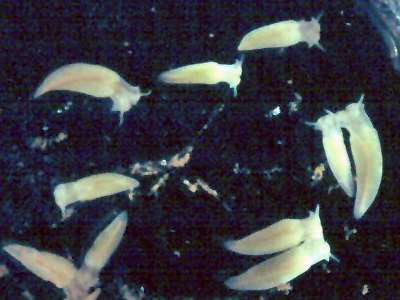
Hi Bill-
While sorting through some slides the other day, I came across the attached photo which I've been meaning to send to you, especially with the off and on again discussions about slug coloration on the Forum. The slugs are Elysia chlorotica "ghosts". Sherman Bleakney discovered and published a report on them a long time ago. I have the citation someplace - if you don't know it, I'll try to dig it out. The remarkable thing about these is that they are yellowish-white, but otherwise a perfectly respectable looking E. chlorotica. No matter how long you starve regular E. chlorotica, they will NEVER lose their green color until just before they die, when they turn a dark brown. The ghosts, on the other hand, eat Vaucheria, just like the regular E. chlorotica, and turn green, but if starved, rapidly (few days) turn yellow again and will die within a few more days if not fed. So they have no ability to sequester the symbiotic plastids - which means they lost the ability or never had it. While E. chlorotica has a fairly broad distribution from at least the Canadian maritimes down to the Chesapeake Bay (some have even reported them in Florida-possible, I suppose), the ghosts have only been seen in a few marshes in Nova Scotia and only occasionally. When I first started working on E. chlorotica, I prevailed on Bleakney to send me a few of the ghosts as I thought they might make interesting controls in our experiments. The ones he sent me are pictured here. We kept them at Woods Hole in natural sea water for a time, but they were such a chore to feed that we ultimately quit. Unfortunately at the that time, I had no inkling that I was going to be interested in their DNA, so the only remnants of these ghosts remain in Epon blocks. However, given our recent work on the molecular biology of the chloroplast symbiosis, it is possible that the DNA from these ghosts would be an incredibly important piece of the puzzle. Usually, every spring, I ask some people at Acadia U to keep an eye out for ghosts in the marshes along the Minas Basin. Bleakney is retired long ago. So far, no one has found any. Perhaps there are some Forum readers in Nova Scotia or perhaps Newfoundland that might have seen ghosts?? If so, please contact me.
Anyway, the collector here was Sherman Bleakney, I'm guessing about 1980, in a salt marsh someplace in the Minas Basin. The ghosts were generally smallish for E. chlorotica, these were maybe 0.5-0.75cm, but I really have no idea how big they get. They eat Vaucheria litorea and probably Vaucheria compacta as well.
Locality: Minas Basin, Nova Scotia, Atlantic Ocean (Bay of Fundy). intertidal. Length: 0.5-0.75 cm. Photographer: Skip Pierce
Skip
pierce@cas.usf.edu
Pierce, S. K., 2005 (Jun 15) Elysia chlorotica "ghosts". . [Message in] Sea Slug Forum. Australian Museum, Sydney. Available from http://www.seaslugforum.net/find/14039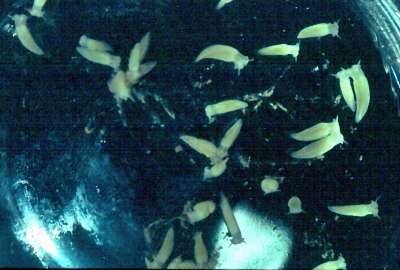
Dear Skip,
I guess the paper you are referring to is the one listed below. From Sherman Bleakney's account in his 1996 book, Sea Slugs of Atlantic Canada and the Gulf of Maine, there is still a lot of work to be done just sorting out the natural history of that species.
-
Gibson, G.D., Toews, D.P. & Bleakney, J.S. (1986) Oxygen production and consumption in the sacoglossan (=Ascog;lossan) Elysia chlorotica Gould. The Veliger, 28(4): 397-400
Best wishes,
Bill Rudman
Elysia chlorotica from Martha's Vineyard, USA
May 14, 2005
From: skip pierce
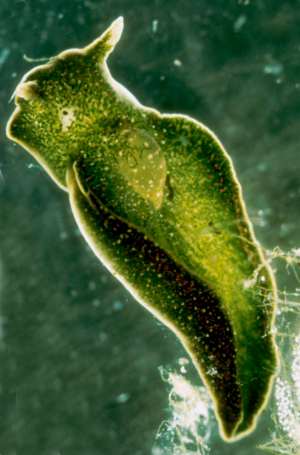
Hi Bill,
We're in process of putting a seminar together on gene transfer between algae and sacoglossans and it reminded me that I've been meaning to send you a photo of Elysia chlorotica and it's egg mass. The photo was taken in the lab several years ago, but I though you might like it. I've filled in the collection location details as best I can remember them.
Locality: Martha's Vineyard, Massachusetts, USA (Atlantic): intertidal salt marsh, Length: 1 cm. Autumn 1990. Photographer: Skip Pierce.
Skip
pierce@cas.usf.edu
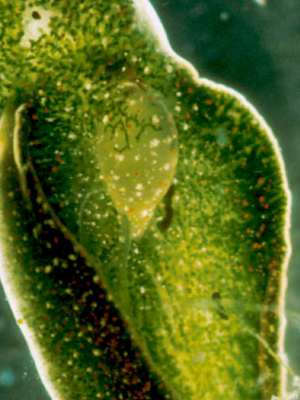
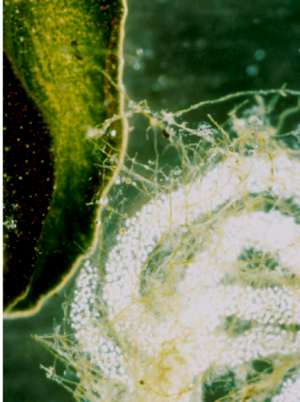
Thanks Skip,
It's a valuable addition as it shows the red and whitish spots so well.
Best wishes,
Bill Rudman
Elysia anatomy
November 13, 2003
From: Kathleen Archer
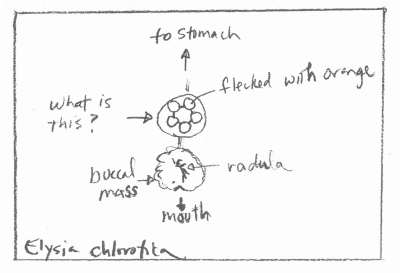
Dear Colleagues,
I'm studying the digestive tract of Elysia chlorotica as part of a project to better understand how chloroplasts of Vaucheria litorea can survive ingestion and function within the animal (see the "Solar-powered Sea Slugs" area). I have a diagram of Elysia (formerly Tridachia) crispata (from Richard Fox's dissection exercise on the web)that I am using as a guide to identify organs and structures. However, there is one organ that doesn't seem to correspond to anything in Richard's diagram. I have included a jpeg image to help show what I will describe here. Starting at the mouth and progressing towards the posterior, I first encounter the buccal mass with the radula. The very next structure is a sphere about the same size as the buccal mass. Inside this sphere are 5 (usually) smaller spheres, and these are interconnected with each other by ductwork. They are flecked with orange, so that the organ is readily detected under the dissecting scope. Can anyone suggest what this structure might be?
Thanks,
Kathleen Archer
kathleen.archer@trincoll.edu
Archer, K., 2003 (Nov 13) Elysia anatomy. [Message in] Sea Slug Forum. Australian Museum, Sydney. Available from http://www.seaslugforum.net/find/11392Dear Kathleen,
What you have is the nerve ganglia which forms a ring around the oesophagus - sometimes loosely called a 'brain'. There are 4 main ganglia - a pair of dorsal cephalic ganglia and a pair of ventral pedal ganglia. In each ganglion there is a set of interconnected nerve cells which form a 'mini-brain'. The flecks of orange you describe are the individual nerve cells which are usually brightly coloured [in you animal they are apparently orange]. The position of individual nerve cells is very constant. This is the reason that the sea hare, Aplysia californica, has become such an important laboratory animal. With such large, easily mapped, individual cells it has become a favourite animal for those studying how brains work.
Best wishes
Bill Rudman
New Paper on Elysia chlorotica
September 22, 2000
From: Elizabeth J. Summer
Hi Bill,
Mary Rumpho's group has published another paper on chloroplast symbiosis in Elysia chlorotica.
The reference is: Brian J. Green, Wei-Ye Li, James R. Manhart, Theodore C. Fox, Elizabeth J. Summer, Robert A. Kennedy, Sidney K.Pierce, and Mary E. Rumpho (2000) Mollusc-Algal Chloroplast Endosymbiosis. Photosynthesis, Thylakoid Protein Maintenance, and Chloroplast Gene Expression Continue for Many Months in the Absence of the Algal Nucleus. Plant Physiology, 124: 331-342.
The most significant findings are:
• 1. at least one algal nuclear encoded protein (a light harvesting complex protein) is maintained in the animal for 9 months in the absence of algal food.
• 2. there is no algal nuclear DNA in photosynthetically active animals
• 3. Chloroplast RFLP analysis supports field observations that Vaucheria litorea is the chloroplast source in the Martha's Vineyard (Massachusetts, USA) population of E. chlorotica - I think this is the first time molecular tools have been used for this sort of analysis.
Thanks,
Liz
Elizabeth J Summer, Ph.D.
Dept Horticultural Sciences
Texas A&M University
College Station TX 77843
elizsum@aol.com
Summer, E.J., 2000 (Sep 22) New Paper on Elysia chlorotica. [Message in] Sea Slug Forum. Australian Museum, Sydney. Available from http://www.seaslugforum.net/find/3048Dear Liz,
Thanks for keeping us up to date with the work going on in Mary Rumpho's lab. From the emails I have had from students, there are a lot of biologists who find this topic fascinating. I have added the reference to my list of Chloroplast Symbiosis References.
Best wishes,
Bill Rudman.
Trouble finding Elysia chlorotica
August 4, 2000
From: Jack Teng
We're at McGill University [Montreal, Canada] under Prof. Dhindsa. How does one obtain this organism? (or similar ones?) We've been looking all over but without a proper snail research background we're stumped. Can you give us some hinters?
much obliged,
Jack Teng
halo_faust@hotmail.com
Teng, J., 2000 (Aug 4) Trouble finding Elysia chlorotica. [Message in] Sea Slug Forum. Australian Museum, Sydney. Available from http://www.seaslugforum.net/find/2832Dear Jack,
By chance a week ago I reviewed Sherman Bleakney's book Sea Slugs of Atlantic Canada... As sacoglossans are one of his special interests, there is an interesting few pages on the problems of doing research on the natural history of Elysia chlorotica because its appearances are so unpredictable. Sometimes you'll find huge aggregations of large animals and then they are gone for years, only to be found somewhere nearby. If your library hasn't a copy, it should, but if you can't convince them to buy one, for $15 you could buy yourself an interesting book which, amongst much more, will give you information on E. chlorotica and a number of other sacoglossans, some of which also have chloroplast symbioses.
I'm afraid the difficulty in getting a predictable and reliable supply of animals for research is a problem with many sea slugs, even some we think of as very common. Good luck with your search.
Best wishes,
Bill Rudman.
Re: Elysia chlorotica & mating chains
May 18, 2000
From: Kathe R. Jensen
Dear Liz (and Bill),
Concerning your message on behaviour in Elysia chlorotica:
The opening and closing response of parapodia has been experimentally studied in Elysia timida from the Mediterranean coast of Israel [Rahat & Monselise (1979) J.exp.Biol., 79: 225-33], and they also showed that the light receptor(s) responsible for the response were not the eyes. Weaver & Clark (1981) [Mar. Behav. Physiol., 7:297-306] found that several species of sacoglossans were most active at dawn and dusk, i.e. low light intensities. In the lab. you usually have the lights either off or on, and the animals will be active for a short time after the lights come on. Also, Kerry Clark suggested in one of his papers that the dorsal vessels might function as a "negative gill" transporting oxygen away from photosynthesizing tissue. This is one aspect of the symbiosis I would like to see the plant physiologists examine. I am very happy to see that someone still work on chloroplast symbiosis.
(Incidentally, Liz, I would be very happy for a reprint of your "cover-story" review).
Kathe
jensen@ait.ac.th
Jensen, K. R., 2000 (May 18) Re: Elysia chlorotica & mating chains. [Message in] Sea Slug Forum. Australian Museum, Sydney. Available from http://www.seaslugforum.net/find/2406Elysia chlorotica & mating chains
May 17, 2000
From: Liz Summer
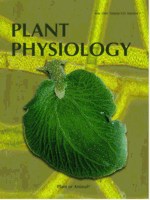
Dear Bill,
Following your photo of Sea Hare mating chains. Our E. chlorotica also forms mating chains of commonly 3 but sometimes more animals. They also have a lot of other peculiar habits - the most striking one is their apparent "sunning" behavior. When the aquarium lights first come on, they quickly glide over under the lights and flatten out (like the picture on the cover of Plant Physiology). After a while, they all go to the "shady" part of the aquarium (i.e. near the corner filter) where they keep their parapodia folded. These are purely anecdotal accounts as none of us are qualified animal behaviorists!
Thanks,
Liz Summer
elizsum@aol.com
Summer, E., 2000 (May 17) Elysia chlorotica & mating chains. [Message in] Sea Slug Forum. Australian Museum, Sydney. Available from http://www.seaslugforum.net/find/2405Dear Liz,
I am sure studying the "sunning' behaviour of any of these solar powered animals would be very interesting. When I was teaching at the University of Dar es Salaam many years ago I used to show students how the little bright-green photosynthetic flatworm Convoluta, which forms green smears across the sand at a certain level on the shore, seemed to adapt its position for optimal light intensity. I would put a 'few' Convoluta [1-200?] in a glass cylinder with sand and seawater and cover the outside of the cylinder so no light can enter from the sides, and then shine a light down from the top. The flatworms would form a distinct green band in the sand. If the light intensity was increased the green band would sink deeper in the sand and vice versa.
Another example would be the specialised tropical elysiid Plakobranchus which lives in coral sand in the glaring light of shallow tropical waters. Unlike temperate elysiids which flaunt their chloroplasts in the sunlight, Plakobranchus hides its chloroplasts under its folded parapodia. My guess is that it is protecting the plastids from being burnt out by too much light. It would be a nice study for someone to undertake.
Any more interesting notes on your solar powered animals, especially with photos, will always be welcome
Best wishes,
Bill Rudman.
Re: Elysia sp. 7 from Texas
May 7, 2000
From: Kathe R. Jensen
Dear Bill,
Flipping through the unidentified Elysias on your species list, I came across your Elysia sp 7 which was posted while I was in the process of moving to Thailand. This species I am almost certain is Elysia chlorotica. The photographs do not show many details, but the drawing excellently shows the broad foot with tentacular processes, the relatively thin rhinophores, the short pericardium, and the numerous dorsal vessels leaving an "empty" space behind the pericardium. The species is also one of the few that can tolerate low salinity. It normally occurs along the coast of NE America, including Canada, but occasionally reaches down to Florida in the winter. This may explain how it reached this place along the intracoastal waterway; my suggestion is that the animals had been hiding on a boat and got dumped along the way. It feeds on a soft, fine filamentous alga, Vaucheria, which forms slippery dark green, almost black mats on estuarine mud- or sandflats.
Kathe
jensen@ait.ac.th
Jensen, K.R., 2000 (May 7) Re: Elysia sp. 7 from Texas. [Message in] Sea Slug Forum. Australian Museum, Sydney. Available from http://www.seaslugforum.net/find/2364Dear Kathe,
Thanks for the id. It's nice to have another 'loose end' tied up. I hope you will be able to recognise some of the other unidentified sacoglossans as well.
Best wishes,
Bill Rudman.
Solar-powered Elysia chlorotica
February 26, 2000
From: Liz Summer

Hi Dr Rudman,
I am a chloroplast molecular biologist in the lab of Dr. Mary Rumpho at Texas A&M University. We are studying the genetic and biochemical basis for the unusual longevity of chloroplast activity in Elysia chlorotica. We couldn't help but notice the absence of images of E. chlorotica on your web site!
Here are some images (courtesy of Dr. Mary Rumpho) of Elysia chlorotica (Gould), and their symbiont chloroplast source, the alga Vaucheria litorea (C. Agardh). The animals were collected in late November from Martha's Vineyard, MA, USA. As the aquarium image shows, they are maintained in artificial sea water without algal food for up to 10 months following collection. In culture, the animals live by photosynthetic carbon fixation, through which they obtain enough energy to even lay eggs. Their ultimate, synchronized death seems to be due to a viral infection endemic in the slug population rather then loss of chloroplast activity.
We also grow V. litorea in order to compare chloroplast activity in the animal vs. the algae. The attached image shows a close up of the algal filaments. Vaucheria is a siphonaceous algae - this means it is designed like a straw - a hard outer cell wall but with few cross walls. It has a multinucleated cytoplasm and many chloroplasts. Because of this design, it is easy for the slug to obtain a full load of chloroplasts by piercing the outer wall and sucking out the inside. V. litorea is a chromophytic algae (containing chlorophyll a & chlorophyll c) that grows as hair-like mats and is ecologically important in stabilizing muddy bottoms.
Elizabeth Summer, Ph.D.
Research Associate
Horticultural Sciences Dept
Texas A&M University
College Station, Texas, USA
elizsum@aol.com
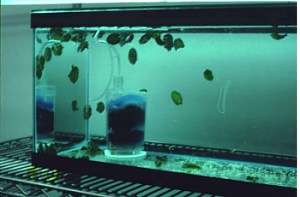
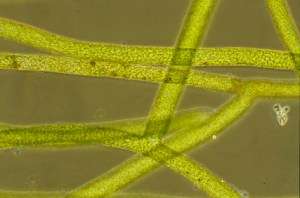
Dear Liz,
Thanks very much for the illustrations and the interesting review of Elysia chlorotica and its ability to live so long without normal feeding. As a long-time fan of Solar-powered Sea Slugs I had been hoping someone would fill the gap, as E. chlorotica certainly deserved some recognition.
If you would like to keep us informed of your work I am sure there are many interested people (other than me) who will read it. Things that would be of interest would be a photo of chloroplasts in an Elysia and an EM photo of a chloroplast. Perhaps you could let me know of any major gaps in my list of chloroplast symbiosis references.
Best wishes,
Bill Rudman.
Elysia from Texas
February 23, 2000
From: Cathy Porter
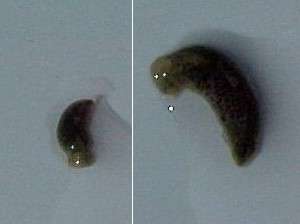
Bill;
We've been catching this organism in our 40 ft seine, in about 8 inches of water, in the Intracoastal Waterway, (a barge canal) [Texas, USA - Caribbean Coast], which receives water from a cut into Matagorda Bay. The cut is across the canal from our preserve, Mad Island Marsh Preserve (The Nature Conservancy, my employer). We've been seining at this location for 5 years now, sometimes twice a week, sometimes once a month. The salinity here has been about 27 ppt. We haven't noticed this critter until January, when we were routinely seining with a retired adults group. The critters survive in refrigeration for several weeks, and enjoy being in the sunlight.
However, we pulled the seine yesterday at the same location and didn't get any of these guys. we did get several mud snails. We viewed these guys with our microprojector, just in case our unknown critters were getting their shells crushed by the dredging operations ongoing in the ICWW. But, they're not the same organism.
I happened to plug in the words "marine nudibranch", and came up with David Behrens name and e-mail address. He seemed interested in the critter and wanted more information. Then he gave me your name.
Bill, our location is 2 hours from anywhere.
I'll let you know more details as I get them.
Sincerely,
Cathy
cwp@wcnet.net
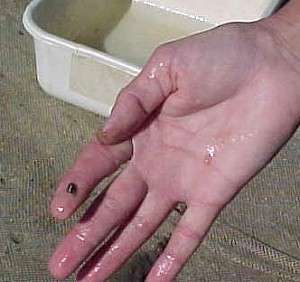
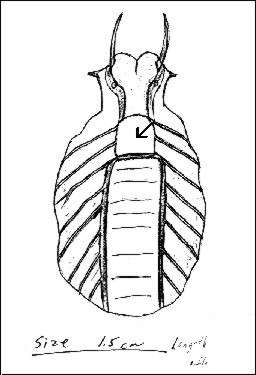
Dear Cathy,
Firstly, although the World Wide Web does create the impression of a global village, the fauna and flora in the global village still changes from place to place. I'm afraid I still need to know where you are [what country, state etc] to give a sensible answer. I presume you are in Texas, USA as it is the only Intracoastal Waterway I have ever heard of but I could be quite wrong.
Your animal is almost certainly a sacoglossan, which are a group of herbivorous sea slugs. If you go to the Species List and look at some of the animals listed in the ORDER SACOGLOSSA you will get an idea of the diversity of these animals. From your sketch I suspect yours is a species of Elysia, but I would need local knowledge to be able to identify it to species.
Many sacoglossans have the interesting ability to keep chloroplasts, from the food they eat, alive in their bodies. They use the sugars produced in photosynthesis for their own nutrition. This could explain why yours seem to like the sunlight. See the page on Solar-powered sea-slugs for further information.
Thanks for the drawing. I presume your animal has a flap down each side of the body which is normally folded over to hide the ducts/veins you have drawn. These flaps are called the parapodia. The raised sac (which I have arrowed) is the renopericardial sac which contains the heart. The anus should open nearby. The network of ducts you have drawn are called 'the dorsal vessels' and their arrangement differs in different species. These ducts open into the pericardium and are filled with blood. Their function is uncertain but they are presumed to be involved with oxygen exchange and excretion.
Hopefully someone from your part of the world can help us with an identification.
Best wishes,
Bill Rudman.
May 2000: Identified by Kathe Jensen as Elysia chlorotica - see message.
Rudman, W.B., 2000 (Feb 23). Comment on Elysia from Texas by Cathy Porter. [Message in] Sea Slug Forum. Australian Museum, Sydney. Available from http://www.seaslugforum.net/find/1901